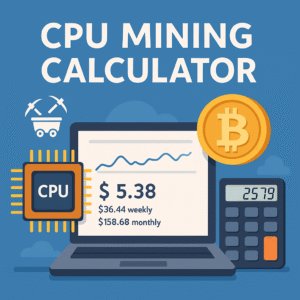
CPU mining calculator
CPU Mining Calculator
CPU mining calculator is an application program that estimates possible returns from cryptocurrency mining with a computer’s central processing unit (CPU). Although GPU and ASIC mining have dominated profitable mining activities, CPU mining remains applicable to particular coins and hobby miners. The calculators enable users to enter parameters like hash rate, electricity price, and type of coin to analyze whether mining with CPU is feasible for them.
With increasing crypto mining complexity, access to accurate, real-time estimations is critical to making decisions. CPU mining calculators close the knowledge gap between individuals just beginning and those optimizing low-power mining rigs.
What Is CPU Mining?
CPU mining is when you use a computer’s CPU to verify and process transactions of cryptocurrency within a blockchain. Essentially, it’s making your computer do some computation to solve cryptographic challenges and receive coins as reward. This is how Bitcoin mining originally began in 2009. You could, at that time, mine directly at home using just a basic computer.
Yet, as Bitcoin’s difficulty level exploded and specialized equipment appeared, mining with CPUs became uneconomical for every mainstream coin. Now, mining with CPUs is employed solely on some privacy-oriented or newer altcoins, such as Monero or VerusCoin, that are ASIC and GPU mining-resistant.
So is CPU mining still worth your time? That’s where the calculator comes in.
What Does a CPU Mining Calculator Do?
A CPU mining calculator uses your hardware and environmental information, does some math, and predicts your earnings. Imagine it as a crypto profit simulator. You input your hash rate (how quickly your CPU can do mining calculations), your power draw, electricity cost per kilowatt-hour (kWh), and any additional information you feel like providing. The calculator estimates:
-
Daily, weekly or monthly income
-
Net profit after electricity expenses
-
Break-even timelines
-
Reward payouts in both crypto and fiat
Certain advanced calculators even include consideration of changes in network difficulty and historical price trends.
Why is CPU Mining Still Relevant?
Although mining with a CPU is less profitable today than it was previously, it still has its place within the cryptocurrency market.
Firstly, it reduces the barrier to entry. Not everybody can afford mining rigs that cost thousands of dollars. CPUs, however, can be found anywhere – desktop computers, laptops, even smartphones. For those who wish to learn about mining and do not wish to spend much, mining via CPU is an obvious place to start.
Secondly, there exist coins that are specifically designed to be mined with CPUs. Such projects prioritize decentralization and do not wish to be mined centrally by ASIC farms. Monero is an example of such an approach. Monero uses the RandomX algorithm, which prefers CPUs and dynamically adjusts to keep itself ASIC-resistant.
Finally, mining can be done with idle computing. If your machine is already running anyway – e.g., to download or render something – you may as well utilize idle cycles.
Key Inputs to a CPU Mining Calculator
To calculate estimates accurately, you will need to know some specific information about your system. Here’s what most mining calculator sites request:
1. Hash Rate (H/s)
This is how many calculations your CPU can do in a second. Hash rates can range greatly depending on your model of processor and algorithm used. If you don’t know what your CPU’s hash rate is for any given coin, you can consult benchmarks online.
2. Power Consumption (Watts)
Your CPU’s TDP (thermal design power) is a good place to start. But keep in mind that other parts in your system like motherboard and RAM draw power as well. You can check your system’s overall draw with a power meter.
3. Cost of electricity (USD per kWh)
The cost can depend on where you live and your electricity supplier. This is important to do accurately, as electricity expense is going to be the primary cost for many miners.
4. Pool Fee (optional)
If you’re mining with a pool (something that many do to receive more uniform payouts), some calculators will allow you to enter the pool’s fee percent.
5. Coin and Algorithm
Each coin has its own mining algorithm. Your computer may be suited to process some algorithms and less well-suited to others. Select the coin you’re mining to view the corresponding numbers.
Examples of Mining Calculators
BitClub
There are several calculators online, each with its strengths. Some are general-purpose, while others are coin-specific. Here are a few common types:
Multi-coin Calculators
Sites such as WhatToMine or Minerstat enable users to enter hardware specifications and compare profitability for several coins. These can be handy if you haven’t decided on a coin as of yet.
Coin-specific Calculators
For Monero, there are websites such as CoinWarz or MineXMR that offer calculators specifically optimised for RandomX. This enables more accurate modeling, particularly if network difficulty changes greatly.
Mobile App Calculators
Some provide cell versions of mining calculators to enable rapid checks. Less informative, they’re convenient for casual users or miners-on-the-go.
To use GPU mining, it has to be installed.
Pros and Cons of CPU Mining Calculators
As any tool would, CPU mining calculators have both advantages and disadvantages.
Nicola
-
Easy to use and usually free
-
Provides rapid feedback regarding profitability
-
Assists comparing coins and strategy
-
Prevents energy and time wastage in uneconomical configurations
Cons
-
Actual results may vary depending on network modifications
-
It doesn’t account for hardware degradation
-
Leans on constant uptime, potentially not representative of everyday use
-
Certain calculators do not reflect real-time difficulty or price information
These calculators should be treated as estimates and not as guarantees.
Tips to Obtain Most Accurate Results
If you would like to see calculator results that mirror reality, then here are some tips.
-
Test real power consumption using a wattmeter and do not just trust specifications.
-
Monitor average uptime. If your system is operating at 8 hours daily, do not assume 24/7 mining.
-
Monitor the temperature and performance of the CPU to maintain continuous mining.
-
Update the coin price and network difficulty regularly to provide real-time accuracy.
-
Use multiple calculators to cross-check outcomes and detect differences.
Remember, mining’s not just about brute power, it’s about efficiency and consistency.
CPU Mining Versus GPU and ASIC Mining
The GPU and ASIC miners excel in profitability, but there’s still a place for CPU mining. The distinctions aren’t only in cost or speed – they represent fundamental design decisions regarding how cryptocurrencies themselves are designed and secured.
They’re versatile, low cost, and highly accessible. They’re suited well to algorithms that oppose hardware specialization.
GPUs provide faster and better parallel processing. They are best suited to Ethereum Classic, Ravencoin, and other such coins.
ASICs are designed to be speedy but inflexible. They’re extremely effective at particular algorithms such as SHA-256 (used in Bitcoin) but find no application elsewhere.
It’s a function of what you’re trying to achieve. Beginners, privacy enthusiasts, and those with limited resources, however, still have a significant option to consider – provided the math works out.
Conclusion
A CPU mining calculator is a valuable resource for any individual mulling over CPU-based mining of cryptocurrencies. Guesswork is removed when estimating profitability as raw numbers translate to meaningful conclusions. Either mining as entertainment, testing altcoins, or performing background jobs when idle, these calculators enable you to make informed, data-based decisions.
Remember that no calculator can forecast the future. But with proper input values, they provide you with good grounds to determine whether mining with your CPU is worth your time and energy.














 Twitter
Twitter
 Telegram
Telegram
